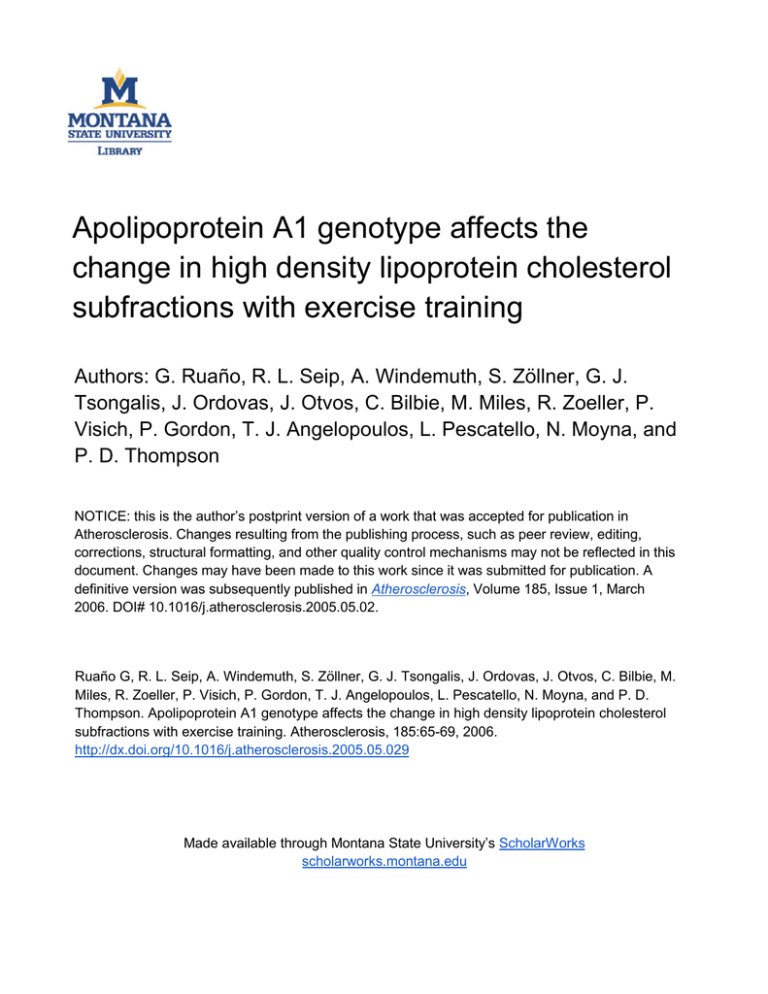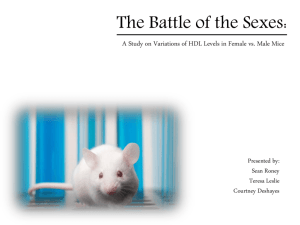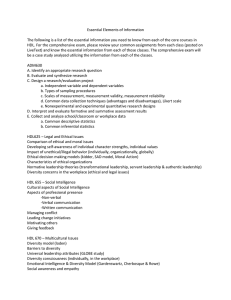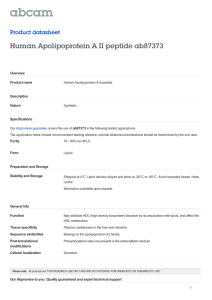Apolipoprotein A1 genotype affects the change in high density lipoprotein cholesterol
advertisement

Apolipoprotein A1 genotype affects the change in high density lipoprotein cholesterol subfractions with exercise training Authors: G. Ruaño, R. L. Seip, A. Windemuth, S. Zöllner, G. J. Tsongalis, J. Ordovas, J. Otvos, C. Bilbie, M. Miles, R. Zoeller, P. Visich, P. Gordon, T. J. Angelopoulos, L. Pescatello, N. Moyna, and P. D. Thompson NOTICE: this is the author’s postprint version of a work that was accepted for publication in Atherosclerosis. Changes resulting from the publishing process, such as peer review, editing, corrections, structural formatting, and other quality control mechanisms may not be reflected in this document. Changes may have been made to this work since it was submitted for publication. A definitive version was subsequently published in Atherosclerosis, Volume 185, Issue 1, March 2006. DOI# 10.1016/j.atherosclerosis.2005.05.02. Ruaño G, R. L. Seip, A. Windemuth, S. Zöllner, G. J. Tsongalis, J. Ordovas, J. Otvos, C. Bilbie, M. Miles, R. Zoeller, P. Visich, P. Gordon, T. J. Angelopoulos, L. Pescatello, N. Moyna, and P. D. Thompson. Apolipoprotein A1 genotype affects the change in high density lipoprotein cholesterol subfractions with exercise training. Atherosclerosis, 185:65-69, 2006. http://dx.doi.org/10.1016/j.atherosclerosis.2005.05.029 Made available through Montana State University’s ScholarWorks scholarworks.montana.edu Apolipoprotein A1 genotype affects the change in high density lipoprotein cholesterol subfractions with exercise training Richard L. Seip, Gregory J. Tsongalis, Paul D. Thompson, Cherie Bilbie; Hartford Hospital, Hartford CT 06102 Gualberto Ruaño, Andreas Windemuth, Stefan Zöllner; Genomas, Inc., 67 Jefferson Street, Hartford, CT 06106, USA Jose Ordovas; Tufts University, Boston, MA, USA James Otvos; North Carolinia State University, Raleigh, NC, USA Mary Miles; Montana State University, Bozeman, MT, USA Robert Zoeller; Florida Atlantic University, Davie, FL, USA Paul Visich; Central Michigan University, Mt. Pleasant, MI, USA Paul Gordon; West Virginia University, Morgantown, WV, USA Theodore J. Angelopoulos; University of Central Florida, Orlando, FL, USA Linda Pescatello; University of Connecticut, Storrs, CT, USA Niall Moyna; Dublin City University, Dublin, Ireland Abstract High density lipoprotein cholesterol (HDL-C) is a primary risk factor for cardiovascular disease. Apolipoprotein A-1 (apoA1) is the major HDL-associated apolipoprotein. The −75 G/A single nucleotide polymorphism (SNP) in the apolipoprotein A1 gene (APOA1) promoter has been reported to be associated with HDL-C concentrations as well as HDL-C response to dietary changes in polyunsaturated fat intake. We examined the effect of this APOA1 SNP on exercise-induced changes in HDL subfraction distribution. From a cohort of healthy normolipidemic adults who volunteered for 6 months of supervised aerobic exercise, 75 subjects were genotyped for the −75 G/A SNP. Of these, 53 subjects were G homozygotes (G/G) and 22 were A carriers (A/G and A/A). HDL subfractions were measured by nuclear magnetic resonance (NMR) spectroscopy by adding categories HDL-C 1 + 2 for the small subfraction, and HDL-C 3+4+5 for the large. The change in total HDL-C after exercise was 0.8 ± 7.2 mg/dL (+1.7%), and was not statistically significant. HDL subfraction amounts also did not significantly change with exercise training in the total cohort or in G homozygotes or A carriers. The amount of the large HDL subfraction increased in the G homozygotes and decreased in the A carriers (mean ± S.E.M., 1.8 ± 6.6 mg/dL versus −6.1 ± 2.3 mg/dL, p < 0.0005). In contrast, the amount of the small HDL subfraction decreased in G homozygotes and increased in A carriers (−1.3 ± 6.6 mg/dL versus 4.7 ± 1.2 mg/dL, p < 0.005). These results show that genetic variation at the APOA1 gene promoter is associated with HDL subfraction redistribution resulting from exercise training. 1. Introduction High density lipoprotein (HDL) particles are a heterogeneous group of lipoproteins with anti-atherogenic properties [1]. HDL participates in reverse cholesterol transport by facilitating the removal of cholesteryl esters from periph-eral tissues and transferring them to either larger triglyceride (TG)-rich lipoproteins via cholesteryl ester transfer protein (CETP) activity or to the liver for excretion. HDL may have other anti-atherogenic effects including protecting low density lipoproteins (LDL) from oxidation; and inhibiting platelet activation [2]. HDL particles consist of a hydrophobic core and a surface layer of phospholipids, unesterified choles-terol and apolipoproteins. Apolipoprotein A1 (apoA1), the major apolipoprotein of HDL, comprises greater than 70%of HDL protein and 30% of HDL mass. HDL cholesterol (HDL-C) concentrations are inversely related to cardiovascular disease (CVD) risk [3]. However, it has been suggested that this protection is stronger for the larger HDL subfractions, such as HDL2b [4–8]. In contrast, decreased large [9–11] and increased small HDL particles [4,12] appear to increase CVD risk. The concentration of cholesterol in relatively discrete HDL size categories can be determined via ultracentrifugation, gel electrophoresis, or nuclear magnetic resonance (NMR) spectroscopy [1]. NMR-based analyses of HDL yields five such categories from the smallest, H1, through the largest, H5 [13]. A common polymorphism in the APOA1 promoter region, the −75 G/A SNP [14], was reported with an allele frequency of about 0.3 in the general population. This polymorphism has been associated with changes in blood pressure [15], vari-ability in the HDL-C response to statins [16] and dietary fat intake [17]. However, the correlation of this polymorphism with apoA1 levels is weak at best based on two large studies [18,19]. We have previously shown that apolipoprotein E (APOE) genotype affects aerobic exercise-induced changes in serum lipids, maximal oxygen uptake [21], and LDL particle size [20]. In the current study, we used this cohort to exam-ine the effect of the APOA1 promoter’s −75 G/A SNP on HDL subfractions following 6 months of aerobic exercise training. 2. Methods 2.1. Study overview The study design and testing procedures have been described in detail [21]. In brief, seven investigators from institutions in the Exercise and Genetics Collaborative Research Group recruited a total of 174 subjects for a 6 month exercise training protocol. Of those completing the training, 75 subjects were genotyped for the APOA1 pro-moter’s −75 G/A SNP and are reported here. 2.2. Subjects Subjects were healthy, without orthopedic problems, non-smokers, physically inactive, between 18 and 70 years of age, body mass index (BMI) �31, and consumed <2 alcoholic beverages daily [21]. They were reimbursed US$ 250 at the end of the study. 2.3. APOA1 genotype determination DNA was extracted from leukocytes and the APOA1 pro-moter variant (−75 G/A SNP, Reference SNP ID, rs670) determined using standard molecular biology techniques [17]. 2.4. Serum lipoprotein measurements Serum was obtained after a 12 h fast before and after 6 months of exercise training. Post training samples were obtained within 24 h of the penultimate or final exercise training sessions. Lipid levels in women before and after training were obtained within 10 days of the onset of menses to avoid variations in lipoprotein values [22]. Lipoprotein subfraction levels and mean particle size were determined by NMR spectroscopy as previously described [23]. 2.5. Exercise program Subjects underwent a 6 month, progressive, supervised exercise program [21]. Subjects exercised at 60–85% of their pre-training maximal exercise capacity for 40 min 4 days weekly. Subjects also participated in 5 min of warm-up and cool-down so that each workout required 40–50 min. 2.6. Data analysis To investigate whether APOA1 genotype affected large and small HDL subfraction responses to exercise, separate group (APOA1 genotype) × gender analyses of variance (ANOVA) on small and large HDL baseline or change scores were performed. Analysis of covariance using only statis-tically significant covariates (p < 0.1) was used to examine the independence of the APOA1 gene effect. Levene’s test was used to test for homogeneity of variance in small and large HDL particle distributions. Sidak’s adjusted post hoc tests were employed when F ratios were significant. For hypothesis testing, significance levels were two-sided with alpha = 0.05. 3. Results Concentrations of six very low density lipoprotein(VLDL), one intermediate density lipoprotein cholesterol (IDL), three LDL, and five HDL subclasses were determined. Anthropometric variables, maximal exercise capacity, and dietary intake were measured as described [21]. Genotyping of the −75 G/A SNP for the 75 subjects in the present study showed that 70% were G homozygotes whereas 30% were A carriers. This frequency is within the range observed for other Caucasian populations [17]. Age, gender, and baseline physiological variables did not differ by APOA1 promoter genotype. Baseline and exercise-induced changes in serum lipids in the present report are based on 75 of the 120 exercise trained subjects reported in our prior paper [21]. Here, we present NMR-derived lipid values whereas the prior report used lipid levels determined by enzymatic techniques. Baseline plasma TGs were significantly (p = 0.037) lower in the G Table 1 Subject characteristics by APOA1 genotype at the −75 G/A SNP Variable BMI Waist Circumference (in.) VO2 max (mL O2 /(kg min)) Total cholesterol (enz., mg/dL) Triglycerides (enz., mg/dL) Total LDL-C (enz., mg/dL) Total HDL-C (enz., mg/dL) Total HDL-C (NMR, mg/dL) Small HDL-C (NMR, mg/dL) Large HDL-C (NMR, mg/dL) ApoA1 (mg/dL) Apo B (mg/dL) All subjects Subjects according to APOA1 genotype at −75 G/A SNP Baseline N = 75) Changes with training (N = 75) 26.9 34.4 31.4 201.7 131.7 130.6 49.0 52.3 13.8 36.9 156.3 118.0 −0.33 −0.66 3.21 −0.31 −16.16 2.1 0.82 −0.3 0.6 −0.9 2.90 −0.90 ± ± ± ± ± ± ± ± ± ± ± ± 4.6 5.7 7.6 39.5 97.3 33.8 13.7 16.7 0.8 2.2 31.6 30.8 ± ± ± ± ± ± ± ± ± ± ± ± 1.02 2.07 4.53 22.78 44.64 2.5 7.17 8.3 0.8 1.3 16.51 14.30 Baseline Changes with training G/G (N = 53) A/G + A/A (N = 22) G/G (N = 53) 26.9 34.1 31.0 202.1 113.1 129.0 50.4 51.8 15.3 36.4 159.5 116.6 27.0 35.2 32.6 200.4 176.5 119.5 45.7 48.2 10.8 37.3 148.6 121.3 −0.23 −0.6 3.1 0.3 −7.5 0.4 1.4 0.3 −1.3 1.8 4.6 −0.1 ± ± ± ± ± ± ± ± ± ± ± ± 4.8 5.7 7.6 40.0 40.0 33.9 15.0 2.2 0.9 2.5 33.9 31.8 ± ± ± ± ± ± ± ± ± ± ± ± 4.4 5.6 7.7 39.1 146.1* 42.3 9.5 (ns) 3.2 1.3 † 3.7 25.8 (ns) 28.6 ± ± ± ± ± ± ± ± ± ± ± ± 1.04 1.6 4.4 22.8 35.1 19.7 6.8 1.2 1.8 1.6 15.4 14.6 A/G + A/A (N = 22) −0.55 −0.7 3.5 −1.7 −37.0 6.3 −0.5 −1.3 4.7 −6.1 −1.2 −2.8 ± ± ± ± ± ± ± ± ± ± ± ± 0.96 3.0 4.3 23.2 57.7* 25.8 8.1 1.8 1.3‡ 2.3† 18.7 13.8 Seventy-fi e individuals were genotyped for the APOA1 −75 G/A SNP. Basic physiological functions and lipid metabolism parameters were determined before and after 6 month of exercise training for evaluation of baseline and exercise-induced changes. Data are means ± S.D. * Significantl different (log transformed TG), ANOVA, p < 0.05. † Significantl different, ANOVA, p < 0.01. ‡ Significantl different, ANOVA, p < 0.001. homozygotes to begin with, and their percentage change in response to exercise training was lower than values for A carriers (p = 0.051). Baseline HDL-C, determined by either enzymatic reaction or NMR spectroscopy technique and APOA1 protein concentration was higher in G homozygotes, but not in a statistically significant manner. Large HDL particle cholesterol did not differ between the groups at baseline (36.4 ± 2.5 mg/dL for G homozygotes versus 37.3 ± 3.7 mg/dL for A carriers, but small HDL particle cholesterol tended to be higher in G homozgotes than A carriers (14.2 ± 0.9 mg/dL versus 10.8 ± 1.5 mg/dL, p = 0.06 mg/dL). There was no effect of the APOA1 promoter −75 G/A SNP on the change in total HDL-C (0.3 ± 1.2 mg/dL (G/G) versus −1.3 ± 1.8 mg/dL (G/A + A/A)) (Table 1). Small HDL-C increased in the A carriers but decreased in G homozygotes (4.7 ± 1.2 mg/dL versus −1.3 ± 1.2 mg/dL, p < 0.005). Con-versely, large HDL-C decreased in A carriers but increased in G homozygotes (−6.1 ± 2.3 mg/dL versus 1.8 ± 1.6 mg/dL, p < 0.0005) (Fig. 1). Changes in lipids and HDL subfractions were generally independent of other factors. We tested for the independence of the APOA1 genotype effect on the HDL subfractions. Baseline values can influence exerciseassociated changes in lipids through regression to the mean. The influence of baseline values on HDL subfraction changes with exercise training was examined using ANCOVA. Baseline small HDL subfraction amount was the only covariate that altered the effect of APOA1 genotype on the change in large HDL sub-fraction amount. Baseline measurements for total cholesterol, LDL-C, HDL-C, log of enzymatic TG, BMI, and waist cir-cumference did not alter the effect of the APOA1 promoter variant effect (all p ≤ 0.021). 4. Discussion Exercise training produces putatively beneficial changes in fasting blood lipids [24]. Exercise decreases total TGs and VLDL-C, and increases HDL-C [24]. These changes occur in proportion to exercise intensity and volume [25]. Other characteristics of lipoprotein particles, such as size [12,26], number [27,28], and chemical composition [28,29], also respond to exercise. Size changes include decreases in VLDL mean diameter, and increases Fig. 1. HDL cholesterol concentrations according to the APOA1 genotype at the −75 G/A SNP. Exercise-induced change in total HDL cholesterol and small and large particle HDL cholesterol was determined by NMR spec-troscopy and is presented separately for G homozygotes (G/G) and A carriers (G/A and A/A). Changes in total HDL cholesterol did not differ between groups (left panel). Small HDL cholesterol increased significantly in A car-riers compared to G homozygotes, p < 0.0005 (middle panel), and large HDL cholesterol decreased significantly in A carriers compared to G homozygotes (p < 0.005, right panel). in LDL and HDL diameters [25]. Recent work has focused on prebeta-1 HDL-C particles, which play an important role in the reverse cholesterol transport (RCT) process and are increased by exercise [36,37]. The HDL-C response to exercise is related to the baseline HDL level [38]. Lipoprotein particle size is increasingly recognized as a risk factor for atherosclerotic CVD. For example, small LDL particles are recognized to be more atherogenic than large particles [30]. HDL particle size may also affect CVD risk. CVD patients have lower levels of large HDL particles than do healthy controls [9,10,31]. High levels of small HDL are also associated with CAD severity [4] and small HDL particles are related to other risk factors for CAD [12]. The present study demonstrates that the common −75 G/A SNP in the APOA1 gene affected the changes in HDL-C subfractions resulting from 6 months of exercise training. The effects of exercise training on G homozygotes were an increase in the amount of large HDL particles and a decrease in the amount of small HDL particles. The effects were reversed in A carriers. Considering only HDL particle size and its relationship to CVD risk, subjects who are G homozygotes appear to benefit more from exercise training than those who are A carriers. Without this genetic stratification, the effects of exercise on HDL particle distribution are masked if not obliterated. The underlying mechanisms for particle size differences are not well understood. Genomic variation influences fast-ing lipids [32], and emerging evidence suggests that genetic variants affect the response to exercise training [21]. Little is known about the specific genetic factors that influence the change in HDL with exercise, despite the prediction that 37%of the variability in the change in HDL-C with exercise is heritable [33]. The primary effect of the APOA1 gene is on HDL and associated subfractions since baseline and exercise-induced change in LDL-C particle size were not associated with the −75 G/A SNP (data not shown). One of the few studies investigating the effect of genetic variants on exercise changes in HDL subfractions [34] found that the endothelial lipase gene, LIPG, Thr111IIe variant affects the exercise-associated increases in large HDL particles. The amount of large HDL particles increased 2.2 mg/dL in the LIPG CC genotype with aerobic exercise compared to only 0.5 mg/dL for the CT + TT genotypes. To our knowledge, the present results are the first to demonstrate that the −75 G/A SNP in the APOA1 promoter is associated with changes in the amounts of both large and small HDL subfractions in response to exercise. Furthermore, a comparison of the exercise effects on HDL subfraction distribution between G homozygotes and A carriers suggests a genetically predictable counterbalance between large and small HDL subfractions. How does the APOA1 gene promoter produce the changes observed in the present study? Apolipoprotein A1 is found in both large and small HDL particle populations. Given the fluid nature of the HDL particle, relatively different amounts of ApoA1 protein could shift the distribution among HDL subcomponents. The variable protein amounts result, in turn, from variable expression of the gene among individuals due to the APOA1 promoter polymorphism. The half-life of HDL apolipoproteins is several days longer in endurance athletes and increases with exercise training [35]. Consequently, there is time for modification of the HDL particle distribution in the circulation, and the time available for this modification may increase with exercise training. It is possible that the APOA1 promoter gene interacts with the increase HDL survival pro-duced by exercise to alter the HDL particle distribution. Con-centrations of circulating factors such as lecithin cholesteryl acyl transferase (LCAT), acylcoenzyme A cholesterol acyl-transferase (ACAT), CETP, or plasma phospholipid transfer protein (PLTP) also change with exercise training and could amplify the effects of even subtle changes in ApoA1 concentration on HDL particle size distribution. It may be asked why no significant change in ApoA1 serum concentration is observed if the effect of the SNP derives from a difference of expression of the gene. We do observe a ∼7% reduction in serum level of ApoA1, but it is not statistically significant. However, lack of statistical significance does not exclude biological significance. A strong decrease in ApoA1 expression may be masked in the serum level by a corresponding increase in the rate of removal of the protein from the serum. We also observed a difference in the exercise response of triglycerides in our data. Exercise lowers blood triglycerides through increased lipase activity and can generate nascent small HDL particles [37,39]. However, the physiological role of the APOA-1 promoter variant in the increase in HDL-C is not clear. Exercise stimulates increased expression of lipoprotein lipase [40], lipolyzing core triglycerides within large TG-rich lipoproteins, reducing overall particle size and causing a loss of surface polar lipids that may become small HDL particles. Without more information it is difficult to relate this event to variation in the APOA1 −75 promoter. In conclusion, a genetic variant in the APOA1 promoter alters the responses of small and large HDL particle distribution to exercise training. These results support the concept that the physiological response to exercise training varies among individuals due in part to genetic variation. References [1] Barter P, Kastelein J, Nunn A, Hobbs R. CN-FFEB: high density lipoproteins (HDLs) and atherosclerosis; the unanswered questions. Atherosclerosis 2003;168:195–211. [2] Brewer Jr HB, Santamarina-Fojo S. Clinical significance of high-density lipoproteins and the development of atherosclerosis: focus on the role of the adenosine triphosphate-binding cassette protein A1 transporter. Am J Cardiol 2003;92:10K–6K. [3] Wilson PW, Abbott RD, Castelli WP. High density lipoprotein cholesterol and mortality. The Framingham Heart Study. Arteriosclerosis 1988;8:737– 41. [4] Freedman DS, Otvos JD, Jeyarajah EJ, et al. Relation of lipoproteinsubclasses as measured by proton nuclear magnetic resonance spec-troscopy to coronary artery disease. Arterioscler Thromb Vasc Biol 1998;18:1046–53. [5] Rosenson RS, Otvos JD, Freedman DS. Relations of lipoprotein sub-class levels and low-density lipoprotein size to progression of coro-nary artery disease in the Pravastatin Limitation of Atherosclerosis in the Coronary Arteries (PLAC-I) Trial. Am J Cardiol 2002;90:89–94. [6] Decossin C, Castro G, Derudas B, et al. Subclasses of LpA-I in coronary artery disease: distribution and cholesterol efflux ability. Eur J Clin Invest 1997;27:299–307. [7] Sich D, Saidi Y, Giral P, et al. Hyperalphalipoproteinemia: characterization of a cardioprotective profile associating increased high-density lipoprotein2 levels and decreased hepatic lipase activity. Metabolism 1998;47:965–73. [8] Asztalos B, Lefevre M, Wong L, et al. Differential response to low-fat diet between low and normal HDL-cholesterol subjects. J Lipid Res 2000;41:321–8. [9] Kuller L, Arnold A, Tracy R, et al. Nuclear magnetic resonance spectroscopy of lipoproteins and risk of coronary heart disease in the cardiovascular health study. Arterioscler Thromb Vasc Biol 2002;22:1175–80. [10] Ballantyne FC, Clark RS, Simpson HS, Ballantyne D. High density and low density lipoprotein subfractions in survivors of myocardial infarction and in control subjects. Metabolism 1982;31:433–7. [11] Pascot A, Lemieux I, Prud’homme D, et al. Reduced HDL particle size as an additional feature of the atherogenic dyslipidemia of abdominal obesity. J Lipid Res 2001;42:2007–14. [12] Williams PT, Krauss RM, Vranizan KM, et al. Associations of lipoproteins and apolipoproteins with gradient gel electrophoresis estimates of high density lipoprotein subfractions in men and women. Arterioscler Thromb 1992;12:332–40. [13] Otvos JD. Measurement of lipoprotein subclass profiles by nuclear magnetic resonance spectroscopy. Clin Lab 2002;48:171–80. [14] Jeenah M, Kessling A, Miller N, Humphries S. G to A substitution in the promoter region of the apolipoprotein AI gene is associated with elevated serum apolipoprotein AI and high density lipoprotein cholesterol concentrations. Mol Biol Med 1990;7:233–41. [15] Sadaf A, Siddiqui S, Lestringant GG, Frossard PM. Apolipoprotein AI promoter variant in blood pressure determination. Clin Genet 2002;61:314–6. [16] Lahoz C, Pena R, Mostaza JM, et al. CN-RSG: Apo A-I promoter polymorphism influences basal HDL-cholesterol and its response to pravastatin therapy. Atherosclerosis 2003;168:289–95. [17] Ordovas JM, Corella D, Cupples LA, et al. Polyunsaturated fatty acids modulate the effects of the APOA1 G–A polymorphism on HDL-cholesterol concentrations in a sex-specific manner: The Fram-ingham Study. Am J Clin Nutr 2002;75:38–46. [18] Juo SH, Wyszynski DF, Beaty TH, Huang HY, Bailey-Wilson JE. Mild association between the A/G polymorphism in the promoter of the apolipoprotein A-I gene and apolipoprotein A-I levels: a meta-analysis. Am J Med Genet 1999;82:235–41. [19] Barre DE, Guerra R, Verstraete R, et al. Genetic analysis of a poly-morphism in the human apolipoprotein A-I gene promoter: effect on plasma HDLcholesterol levels. J Lipid Res 1994;35:1292–6. [20] Seip RL, Otvos J, Bilbie C, et al. The effect of apolipoprotein E Genotype on serum lipoprotein particle response to exercise. Atherosclerosis (in press). [21] Thompson PD, Tsongalis GJ, Seip RL, et al. Apolipoprotein e genotype and changes in serum lipids and maximal oxygen uptake with exercise training. Metabolism 2004;53:193–202. [22] Richard P, Thomas G, de Zulueta MP, et al. Common and rare geno-types of human apolipoprotein E determined by specific restriction profiles of polymerase chain reaction-amplified DNA. Clin Chem 1994;40:24–9. [23] Otvos JD, Jeyarajah EJ, Bennett DW. Quantification of plasma lipoproteins by proton nuclear magnetic resonance spectroscopy. Clin Chem 1991;37:377–86. [24] Durstine JL, Grandjean PW, Cox CA, Thompson PD. Lipids, lipoproteins, and exercise. J Cardiopulm Rehabil 2002;22:385–98. [25] Kraus WE, Houmard JA, Duscha BD, et al. Effects of the amount and intensity of exercise on plasma lipoproteins. N Engl J Med 2002;347:1483–92. [26] Thomas TR, Smith BK, Donahue OM, et al. Effects of omega-3 fatty acid supplementation and exercise on low-density lipoprotein and high-density lipoprotein subfractions. Metabolism 2004;53:749–54. [27] Wilund KR, Colvin PL, Phares D, Goldberg AP, Hagberg JM. The effect of endurance exercise training on plasma lipoprotein: AI and lipoprotein AI:AII concentrations in sedentary adults. Metabolism 2002;51:1053–60. [28] Halle M, Berg A, Konig D, Keul J, Baumstark MW. Differences in the concentration and composition of low-density lipoprotein subfraction particles between sedentary and trained hypercholes-terolemic men. Metabolism 1997;46:186–91. [29] Frey I, Baumstark MW, Berg A. Acute and delayed effects of prolonged exercise on serum lipoproteins. I. Composition and distri-bution of high density lipoprotein subfractions. Eur J Appl Physiol Occup Physiol 1993;66:521–5. [30] Krauss RM. Triglycerides and atherogenic lipoproteins: rationale for lipid management. Am J Med 1998;105:58S–62S. [31] Gofman JW, Young W, Tandy R. Ischemic heart disease, atherosclerosis, and longevity. Circulation 1966;34:679–97. [32] Knoblauch H, Bauerfeind A, Krahenbuhl C, et al. Common haplotypes in five genes influence genetic variance of LDL and HDL cholesterol in the general population. Hum Mol Genet 2002;11:1477–85. [33] Leon AS, Gaskill SE, Rice T, et al. Variability in the response of HDL cholesterol to exercise training in the HERITAGE Family Study. Int J Sports Med 2002;23:1–9. [34] Halverstadt A, Phares DA, Ferrell RE, et al. High-density lipoprotein-cholesterol, its subfractions, and responses to exercise training are dependent on endothelial lipase genotype. Metabolism 2003;52:1505–11. [35] Herbert PN, Bernier DN, Cullinane EM, et al. High-density lipoprotein metabolism in runners and sedentary men. JAMA 1984;252:1034–7. [36] Olchawa B, Kingwell AB, Hoang A, et al. Physical fitness and reverse cholesterol transport. Arterioscler Thromb Vasc Biol 2004;24:1087–91. [37] Jafari M, Leaf DA, MacRae H, et al. The effects of physical exercise on plasma prebeta-1 high-density lipoprotein. Metabolism 2003;52:437–42. [38] Williams PT. The relationships of vigorous exercise, alcohol, and adiposity to low and high high-density lipoprotein-cholesterol levels. Metabolism 2004;53:700–9. [39] Sviridov D, Kingwell B, Hoang A, Dart A, Nestel P. Single session exercise stimulates formation of prebeta 1-HDL in leg muscle. J Lipid Res 2003;44:522–6. [40] Seip RL, Angelopoulos TJ, Semenkovich CF. Exercise induceslipoprotein lipase gene expression in skeletal muscle but not fat in sedentary adults. Amer J Physiol Endocrinol Metab 1995;268:E229–36.




